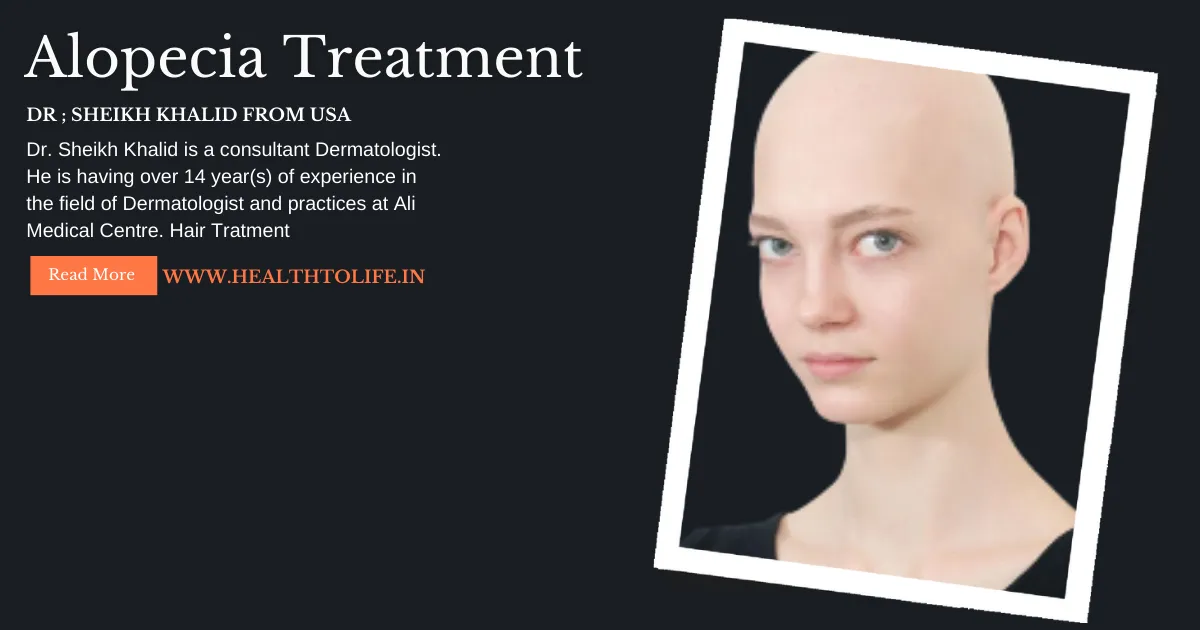
Introduction
Alopecia treatment Alopecia, a condition many people might have heard of but not fully understand, affects millions worldwide. Simply put, alopecia is the medical term for hair loss. While it’s natural to lose some hair daily, alopecia refers to more significant hair loss, often in patches, which can be distressing.
Table of Contents
What is Alopecia?
Alopecia is a condition that results in the partial or complete absence of hair from areas of the body where it usually grows, primarily the scalp. It can affect both men and women and can occur at any age.
Sorts of Alopecia
There are several types of alopecia, with the most common being
Alopecia Aerate
Sudden hair loss that starts with one or more circular bald patches.
Androgenetic Alopecia
Also known as male-pattern baldness or female-pattern baldness.
Alopecia Totals
Complete loss of hair on the scalp.
Alopecia Universalism
Total loss of hair on the body.
Causes of Alopecia
Understanding the causes of alopecia is crucial for effective treatment. Let’s dive into the main factors.
Genetic Factors
Your genes play a significant role in determining whether you’ll experience hair loss. If your parents or close relatives have experienced alopecia, you’re more likely to face it too.
Hormonal Changes
Hormonal imbalances, particularly related to thyroid issues or pregnancy, can trigger alopecia. The hormonal shifts can disrupt the hair growth cycle, leading to hair loss.
Medical Conditions
Certain medical conditions, such as autoimmune diseases, can cause alopecia. For instance, alopecia areata is an autoimmune disorder where the immune system attacks hair follicles.
Lifestyle and Environmental Factors
Stress, poor diet, and exposure to toxins can contribute to hair loss. Lifestyle choices, such as smoking and excessive alcohol consumption, can also exacerbate the condition
Alopecia Treatment: 6 Natural Methods
Very little is known about how you can effectively treat Alopecia Areata because many people wrongly view it as a cosmetic disorder. Unfortunately, the vast majority of dermatologists still share the outdated belief that diet and compromised body systems are unrelated to the aetiology of hair loss (Alopecia Areata). Big Pharma drug products being sold (like Rogaine) take full advantage of the public’s lack of knowledge on the subject. You can cure alopecia areata hair loss, but you must get to the root of the cause as opposed to trying to treat the symptoms.
Here are 6 natural methods that are proven through science that will help you reverse Alopecia Areata by getting to the root cause of the problem.
- The first one is to supplement with a combination of curcumin & trans-resveratrol. Research shows that Alopecia areata is driven by cytotoxic T lymphocytes and is reversed by JAK inhibition. Natural substances such as curcumin & trans-resveratrol can naturally modulate the Jack stat pathway. In layman’s terms, this means that this is a key physiological regulator of inflammation and is an important regulator of adaptive immunity in the body. Taking one of each per day in the morning is highly recommended.
- Additionally, some physicians think alopecia areata may also be a result of a deficiency in the immune system, since in many cases the hair can and does often re-grow spontaneously. Scientists are now discovering that almost all chronic autoimmune diseases are directly tied to stress and inflammation, which can cause deficiencies in the immune system. Alopecia areata hair loss is no exception. Eating a diet rich in omega-3 fats and low in omega-6 fats is the very best way to reverse chronic inflammation damage and return our bodies to a state of balance. Taking an omega-3 supplement every day should help speed your recovery even more. We recommend Krill Oil.
- Vitamin D has a well-established effect on the immune system and is linked to a variety of autoimmune diseases. Recently, researchers at the Şişli Etfal Training and Research Hospital in Turkey conducted a study to determine if vitamin D levels relate to Alopecia Areata and how vitamin D may affect disease severity. They found that Deficient Vitamin D levels are present in patients with Alopecia areata and inversely correlate with disease severity We recommend supplementing with vitamin D daily to help with your recovery.
- The 4th supplement is called Quercetin. Quercetin is a flavonoid found in apples, grapes, and onions. In human studies, it has been shown to block the manufacture and release of inflammation-causing substances. In the case of Alopecia Areata (AA), there is an established correlation between the onset of AA and the release of Heat Shock Protein HSP70, involved in the inflammatory response. In a study, HSP70 was inhibited by both local and systemic administration of Quercetin, and effectively helped prevent the onset of AA, and helped resolve AA. Additionally, it helps reduce anxiety and corticotropin-releasing hormone and modulates the hypothalamic-pituitary-adrenal axis,so it’s a win-win supplement for anybody suffering from alopecia areata. We suggest taking 500 mg in the morning.
- It’s always critical to use a topical aid to boost your hair and help alleviate hair loss until you get your body’s hormones under control. The supplements help your body from the inside out, and an effective topical directly addresses the scalp and hair from another front. Avoid chemicals and opt for a natural topical that does not create dependent hairs but rather thickens and strengthens hair in a natural way. You may have heard that certain essential oils topically are effective against alopecia areata hair loss by stimulating hair growth, eliminating bacteria buildup on your scalp, and helping calm inflammation. Well, this is true. A study conducted by the Department of Dermatology in Aberdeen, United Kingdom, conducted a 7-month study proving essential oils can successfully help treat Alopecia Areata. Another recent scientific study even showed that Rosemary Essential Oil (just by itself) outperformed Monoxides, which is the ingredient in the mainstream product Rogaine. You should consider adding essential oils to your nightly routine. Studies below.
- The last but not the least step is to avoid traditional shampoos and only use natural hair care products. You can probably pick out shampoo faster than it takes you to read our recommendations, but accidentally snagging a bad one can strip your hair of protective oils, cause breakage, and even contribute to hair loss, which means choosing one with no sulfates or parabens. This is especially true when you are suffering from alopecia areata. It’s critical that you wash every day to remove buildup so the new hairs can come in. S,o really make sure to avoid sulfates and pick out a great shampoo. If you’re wondering what a good shampoo is, anything with essential oils or biotin.
Conclusion
Alopecia is a multifaceted condition that requires a comprehensive approach to treatment and management. By understanding the causes, exploring various treatments, and adopting preventive measures, those affected by alopecia can manage their condition effectively and maintain a positive outlook.
FAQ
Ques-1, Can alopecia be cured permanently?
Ans: Currently, there is no permanent cure for alopecia, but various treatments can help manage the condition and promote hair regrowth.
Ques-2, Are there any side effects to alopecia treatments?
Ans: Some treatments, like medications, can have side effects. It’s important to discuss these with your doctor to weigh the benefits and risks.
Ques-3, How long does it take to see results from treatments?
Ans: Results can vary depending on the treatment. Some people may see improvements within a few months, while others might take longer.
Ques-4, Can stress really cause alopecia?
Ans: Yes, stress can trigger or worsen alopecia. Managing stress is an important aspect of preventing and treating hair loss.
Ques-5, Are there any new treatments on the horizon?
Ans: Research is ongoing, and new treatments like stem cell therapy and advanced PRP methods are being explored, offering hope for more effective solutions in the future.
Related Video | Alopecia Treatment Related Video
Was this article helpful?
Stay updated with the latest posts on HealthToLife—expert health tips, wellness trends, and life-changing advice you don’t want to miss. Click to explore.



